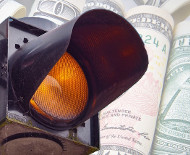Article from: www.thenewspaper.com/news/51/5144.asp
2/8/2017
Fremont, California Caught Shortening Yellow Times
Documents show Fremont, California boosted red light camera profit $200,000 per month by shortening yellow time.
 Short yellow times meant big cash for the city of Fremont, California. Merely by shaving 0.7 seconds from the yellow light timing at a pair of intersections one year ago, the city's private ticketing vendor, Redflex Traffic Systems, was able to generate nearly $200,000 a month in extra citations over the course of nine months. The Highwayrobbery.net website uncovered the evidence during a routine review of red light camera program records.
Short yellow times meant big cash for the city of Fremont, California. Merely by shaving 0.7 seconds from the yellow light timing at a pair of intersections one year ago, the city's private ticketing vendor, Redflex Traffic Systems, was able to generate nearly $200,000 a month in extra citations over the course of nine months. The Highwayrobbery.net website uncovered the evidence during a routine review of red light camera program records.
Originally, the intersection of Mowry Avenue and Farwell Drive and the intersection of Mowry Avenue and Blacow Road each had a 4.0 second yellow time. In August 2015, the city had no choice but to boost the timing to 4.7 after the California Department of Transportation (CalTrans) applied new signal timing regulations requiring the use of realistic speed estimates when timing lights. Then the city decided in February 2016 to switch the traffic survey used so that it could lower the speed limit and slash the yellow back to 4.0 seconds at both locations.
The effect was immediate. Increasing the yellow time by 0.7 seconds in 2015 slashed the number of tickets issued at Farwell Drive by 77 percent, and shortening it back to 4.0 seconds in February 2016 caused a 445 percent spike in ticketing. At Blacow Road, the change to a 4.7 second yellow slashed violations by 68 percent. Shortening it back to 4.0 seconds sent violations skyward by 883 percent. In November 2016, the city decided to switch back to the 4.7 second yellow time for undisclosed reasons.
In a 2010 memorandum to the city council, Fremont Police Lieutenant Tom Mikkelsen asserted that his department maintained close oversight over yellow timing, as required under the state's 2004 red light camera law.
"The legislation states that it is the city's obligation to maintain overall control and supervision of the program," Lieutenant Mikkelsen wrote. "Staff has always and will continue to do the following... Oversee the established industry standard of signal phases and timing."
City leaders are also fully aware of the impact that a small change in yellow time can have on citations. In 2010, a local activist, the late Roger Jones, asked CalTrans to investigate the signal timing at the intersection of Mission Boulevard and Mohave Drive. CalTrans agreed with Jones that the timing was too short and ordered Fremont's engineers to boost the yellow from 4.3 to 5.0 seconds. The number of monthly tickets issued at the location immediately plunged and stayed down by an average of 77 percent, while in the rest of the city the average number of tickets issued did not change. In fact, the city formally recognized that the cameras by themselves did nothing to reduce violations.
"When first implemented, it was staff's opinion that the number of citations issued would drop significantly after the first two years due to heightened public awareness; in reality, the number of citations appears to have remained fairly consistent," Lieutenant Mikkelsen wrote.
In an interview with KPIX television on Friday, Fremont Public Works Director Hans Larsen blamed an intern for writing the wrong yellow timing numbers on paperwork. He also blamed the increase in citations in part on rising traffic volume. However, an April 2016 study by DKS Associates commissioned by the city showed traffic volume dropped after the installation of cameras at all four photo enforced intersections that were studied. At Mission and Mohave, for example, traffic was down 21 percent while during the photo enforced period. The study also confirmed that the use of cameras provided no safety benefit despite the $5.7 million worth of tickets issued at that intersection alone.
"The intersection of Mission Boulevard and Mohave Drive however showed a two percent increase in crash rate for the entire intersection but a five percent increase in crash rate for automated red light enforcement approaches," the DKS study observed. "The smaller percent change observed at Mission Boulevard and Mohave Drive may potentially be due to a low number of crashes that occurred in the three-year period before automated red light enforcement was installed."
After the yellow light time was increased at Mission and Mohave in 2010, Redflex began ticketing people for making right hand turns on red. By 2014, right turn tickets accounted for 71 percent of the citations issued. Fremont's contract with Redflex expires at the end of June.
 Short yellow times meant big cash for the city of Fremont, California. Merely by shaving 0.7 seconds from the yellow light timing at a pair of intersections one year ago, the city's private ticketing vendor, Redflex Traffic Systems, was able to generate nearly $200,000 a month in extra citations over the course of nine months. The Highwayrobbery.net website uncovered the evidence during a routine review of red light camera program records.
Short yellow times meant big cash for the city of Fremont, California. Merely by shaving 0.7 seconds from the yellow light timing at a pair of intersections one year ago, the city's private ticketing vendor, Redflex Traffic Systems, was able to generate nearly $200,000 a month in extra citations over the course of nine months. The Highwayrobbery.net website uncovered the evidence during a routine review of red light camera program records.